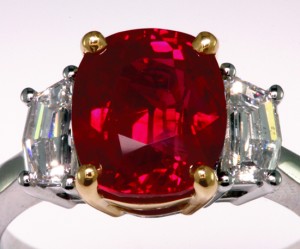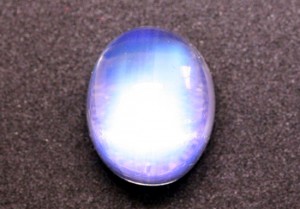
A gem dealer and friend sent me this photograph of what he says is the largest Russian Alexandrite of quality currently on the market.
His excuse for the quality of the photo is that it was taken with a cell phone camera in the lunch area outside the GJX show during this year’s Tucson gem event! I can just picture a gaggle of dealers, clustered around the owner in the midst of the lunch hubub of Tucson, armed with their pocket flashlights, walking in and out of natural sunlight, gawking at this stone. You have to love this business!
At the time, the stone was just for show and tell, but now it’s apparently on the market.
While it’s somewhat included, the outstanding color change is fabulous. And, of course, in the world of fine gems, 27.71 cts. makes it the Godzilla of Alexandrites.
The owner is being somewhat cagey and hasn’t set a price, but supposedly is looking to sell. Some folks succumb to the cardinal sin of the gem dealer, falling in love with their own merchandise, so we’ll see if this gentleman really wants to sell his favorite “pocket rock”. But it’s also really typical with gems at this level for the owners to be really secretive when selling. We’ll keep you posted if anything crystallizes!
We’ve all heard that question, lately more and more in this difficult economy. Not an easy question to answer- it all depends on what it is, who’s buying, who’s selling. For a discussion of the issues related to appraising estate or used jewelry, visit the Mardon blog

Fabulous 6 ct Thai ruby ring, Bayco
The rebirth of the Burma ruby production in the early 90’s has all but vanquished the Thai ruby from the market place. What small production remained has been totally decimated by the current economic collapse- the miners have fled back to the rice fields just to survive.
Yet, the Thai ruby has a following. A trace of iron accounts for the different color displayed. For those who prefer a more subtle red, it’s just the ticket. Our most recent Mardon blog compares pictures of several types of ruby.

4 ct. Pigeon's Blood Ruby, photo by Van Pelt
The best rubies from Burma have long been designated as Pigeon’s Blood red, a rather poetic descriptive term that has come to be an actual grading term, signifying the most sought after color in ruby. Below are photos of some other Pigeon’s Blood stones we have known!

5 ct. Ruby, courtesy of Schofield

4.5 ct. ruby, courtesy of Fai Dee

6 ct. ruby, courtesy of Fai Dee
In the second of several blogs on the subject, we attempt to describe the color and show several photos of the same 4 ct. stone to illustrate how color display and perceptions can vary.

A Perfect Example of the Pigeon's Blood Color, photo by Jim Sweaney
We sold this fine and rare 4 ct. Burma ruby, documented by the GRS lab in Switzerland as Pigeon’s Blood Red- it’s value has increased about 50% in 4 years, even in today’s turbulent economy. Great stones like this are now very difficult to find- not only are they increasingly rare in nature, but mining activity has diminished substantially. And the effect of the embargo of Burma rubies and jade has been to restrict supply.
The Pigeon’s Blood Ruby is almost an archetype in our trade, and with good reason. While some experts prefer one secondary hue over another, the raw power of this red, when seen in fine examples like this is not to be forgotten.
We’ll be discussing various aspects of the ruby over the next few weeks- watch for these posts here and on the Mardon Blog

Cad Rendering
Our client wanted a large wearable ring for her 8 mm diamond, with peirced work and floral elements reminiscent of Victorian and Edwardian times. We found a great matched pair of padparadscha sapphires as accents. Hand engraving was the key to making this design sing- see the finished product on the Mardon Blog!

Actually, more often than not, it is hers and his- we made her custom natural alexandrite and diamond engagement ring first. Then we made her matching wedding band. Then we made a custom wedding band for him, based on the her design. It’s really fun when both bride and groom are involved in the design process- that’s the best for a custom designer. CAD/CAM really enables us to use the client’s input effectively. More about this project and our design philosophy on the Mardon Blog

Classic Ceylon Moonstone
This gorgeous 6.85 ct. moonstone from Sri Lanka exhibits perfect adularescence. Moonstones like this are sometimes called Adularia, after their discovery near the Adula Mountains of the Swiss Alps. Adularescence is also referred to as schiller (shiller), and is caused by alternating layers of albite and orthoclase feldspar interfering with light. Interestingly, the more closely packed the layers are, the bluer the sheen. For more discussion, read our Blog.
Send us pix of your favorite moonstone jewelry or your pet moonstone! We welcome your comments.

Double Akoya Pearl Necklace
While reviewing material for a recent blog on the plight of the Japanese akoya pearl farmers, I was struck by one index card from a presentation we made at the 50th Anniversay AGS Conclave in New Orleans in 1984. I worked in the pearl business with John Latendresse in the early 1980’s, and even then, the handwriting was on the wall– the Japanese akoya cultured pearl industry was in trouble, and its competitors were gathering strength.
On the card was a discussion of some of the problems facing the Japanese industry including environmental degradation, diseases and genetically weak pearl oysters, and diminishing skilled labor resources. At that time, we predicted a decline for the Akoya industry, moderate growth for the South Sea farms, and a great future for the Chinese pearl farmers, both freshwater and saltwater. Time has shown this prediction to be accurate. Visit our blog, The Pearl Farms of Japan, Going, Going, G…

Clues to a successful marriage
This Art Deco bracelet was either modified by the original seller or by an owner. The remnant tubing and center join indicates the middle section of the bracelet may have originated as a pair of clips or a buckle of some type. Pairs of diamond clips were de rigueur during the 1930’s, especially with the two clips being mirror images of each other. See the front of this nice looking bracelet and a discussion of married jewelry on the Mardon blog.












